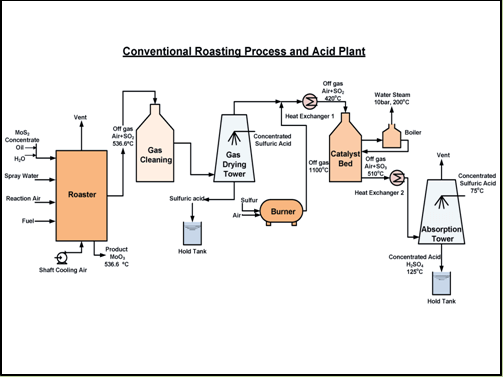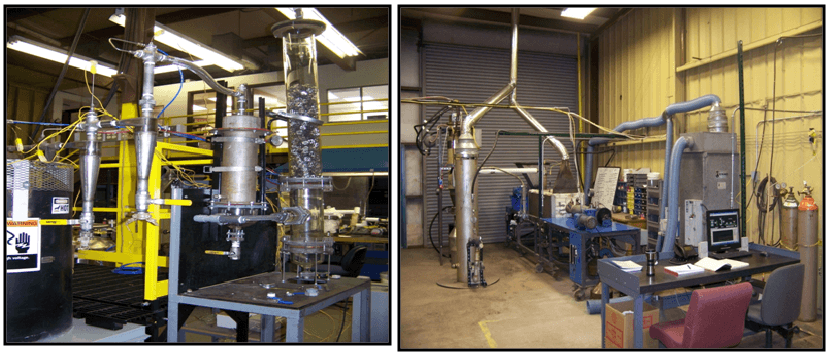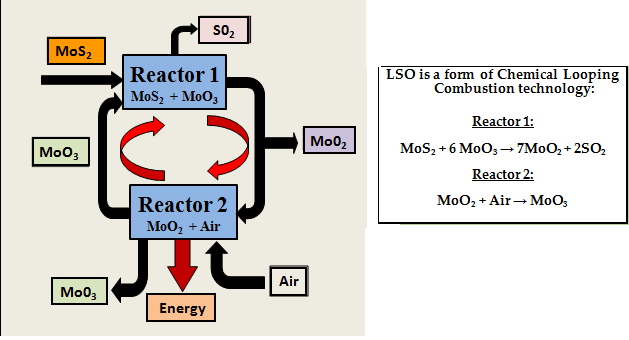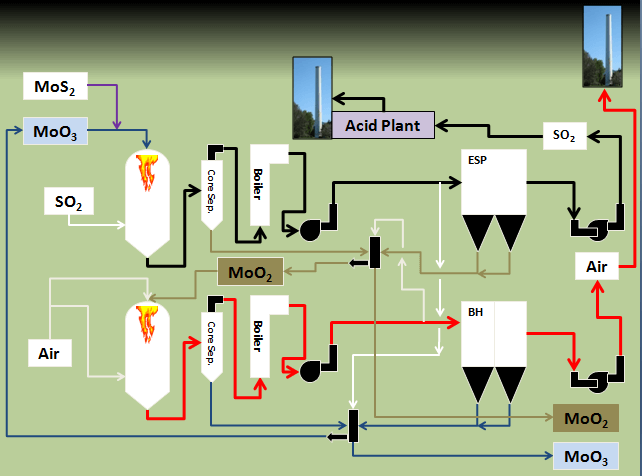Molybdenite Roasting with Sulfuric Acid Plant VS Looping Sulfide Oxidation (LSO) with Sulfuric Acid Plant
- Engineering Design
- Construction
- Training & Start-up
- Capital Cost Studies
- Feasibility Studies
- Operations & Maintenance
- Peer Reviews
- Modernization
- Capacity Expansion
- Patents and Papers
MoS2 Roasting Experience
- Fort Madison, IO, USA
- Sierrita, AR. USA
- Langeloth, PA. USA
- Washington, PA. USA
- Winslow, NJ, USA
- Eureka, Nevada, USA
- Rotterdam, Netherlands
- Trollhaettan, Sweden
- Le Giffre, France
- Spigno Montferrato, Italy
MoS2 Roasting Experience
- Mejillones, Chile
- Chuquicamata, Chile
- Huaxian, Shaanxi, China
- Louyang, Henan, China
- Yeosu, South Korea
- Sorsk, Russia
- Chelyabinsk, Russia
- Yerevan, Armenia
- Stowmarket, UK
- Goslar, Germany
Current Multiple Hearth Roasting

Molybdenite MHR – Advantages
- Multiple Hearth Roasters are available reliable furnaces.
- Roasting reactions are slowed allowing for furnace temperature control.
- SO2 off-gas can be fed to recovery processes which also produce a salable by-product. (Sulfuric Acid)
- Existing equipment is utilized with non-exotic materials of construction.
Molybdenite MHR – Disadvantages
- Significant energy recovery is not possible.
- Reactions are slow and inefficient requiring large surface area roasting equipment size.
- Operating Labor and Operating conditions are less than ideal. (Cleaning of Arms, Teeth, Dropholes, Off-Gas Ductwork, etc.)
- Low concentration SO2 off-gas can be fed to the acid plant but generally need additional fuel or SOx for acid conversion.
- Low SO2 levels require large gas cleaning and acid plant volume capacities.
LSO Looping Sulfide Oxidation Development
Mo Looping Sulfide Oxidation – Patent

LSO Pilot Plant Tests

Molybdenite LSO Continuous Process Reactor Systems
Looping Sulfide Oxidation – LSO
- The two-step “looping oxidation” process effectively removes sulfur while producing products of excellent purity in an energy generating and environmentally friendly manner.
Reactor 1: MoS2 + 6 MoO3 → 7MoO2 + 2SO2
Reactor 2: MoO2 + Air → MoO3 - OMT’s new patent greatly increases the energy generation potential of LSO.
Molybdenite LSO

Molybdenite LSO – Advantages
- Significant energy generation is economically attractive.
- Rich SO2 off-gas can be fed to efficient ancillary recovery processes which also produce energy.
- Reactions are fast and efficient allowing for reduced equipment size.
- Maintenance costs reduced and Operating Labor and Operating conditions are greatly improved.
- Commercially available equipment is utilized with non-exotic materials of construction.
- Efficient rhenium recovery is also possible.
- Both LSO reactors operate in an exothermic manner allowing for stable rapid reaction kinetics.
- SOx strength will exceed levels achievable by any other process. This will allow for smaller acid plant equipment or greatly increased efficiency of an existing acid plant.
- MoO2 can be produced which is a better product for alloy steel applications. MoO2 has a higher Mo content and is more stable in alloying practice improving recovery of Mo into the alloy steel.
- High solubility MoO3 and/or MoO2 can be produced in any desired ratio.
High Energy Looping Sulfide Oxidation
Molybdenite LSO Facility

NEXT – LSO Pyrometallurgy
- The ‘Looping Process’ can be utilized to generate energy and treat other large volume primary metals.
- To date positive results have also been demonstrated with:
- Mo, Co, Cu, Fe, CuFe – Sulfides
- Evaluations continuing with:
- Ni, Zn, Sn, Pb
- Energy generation from the Acid Plant is also large and quantified.
- SO2 condensation and recovery is also a viable SOx recovery method.
